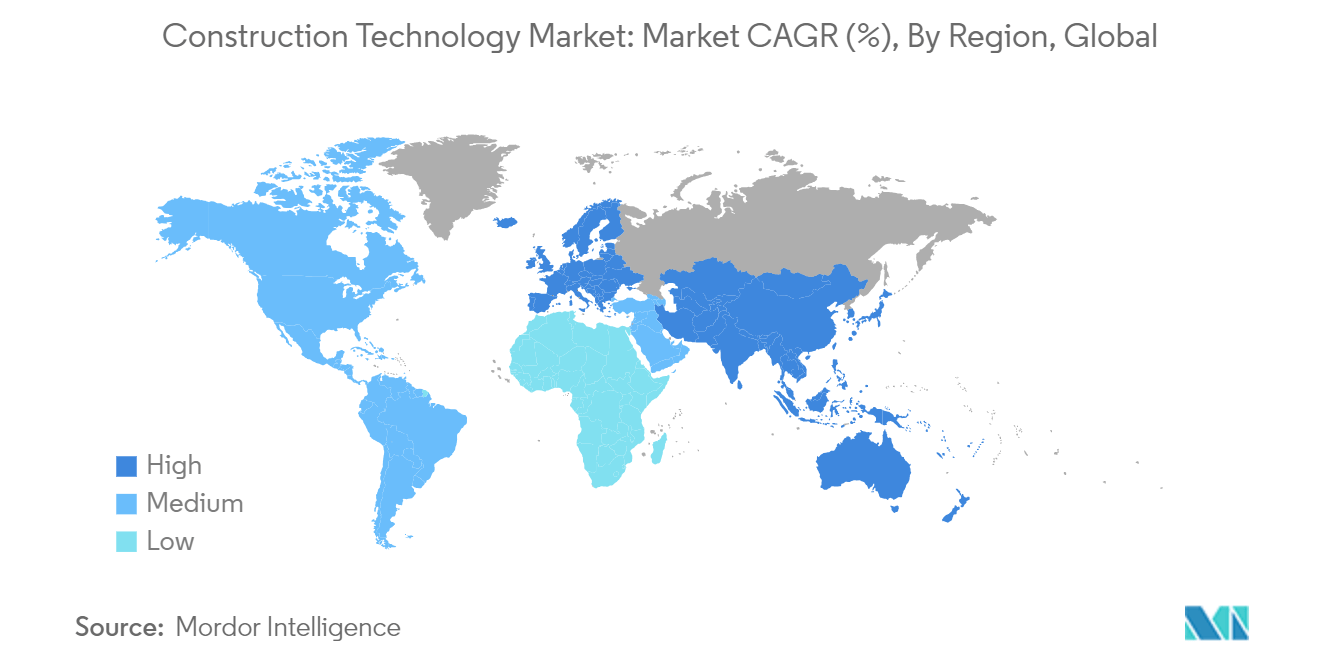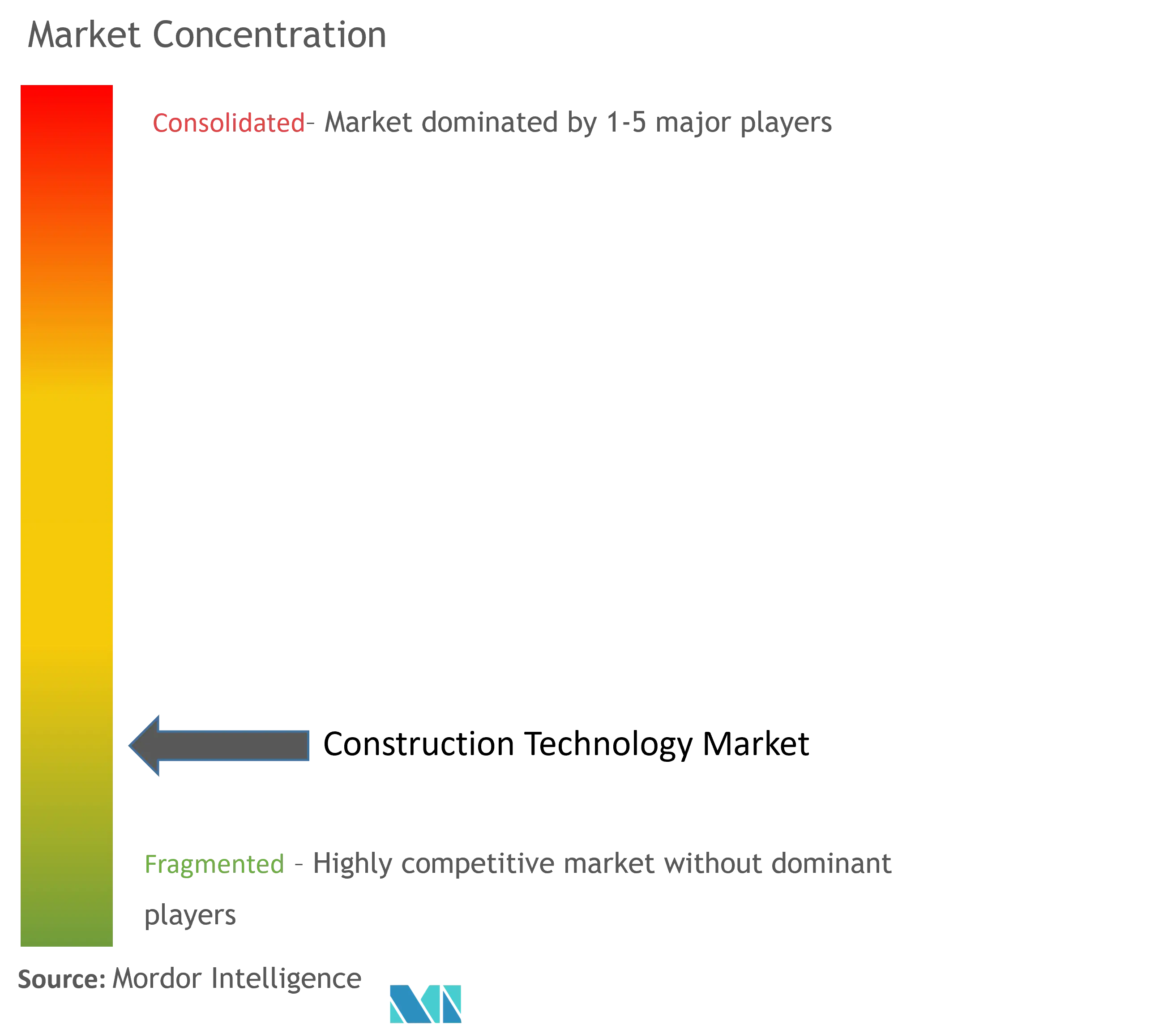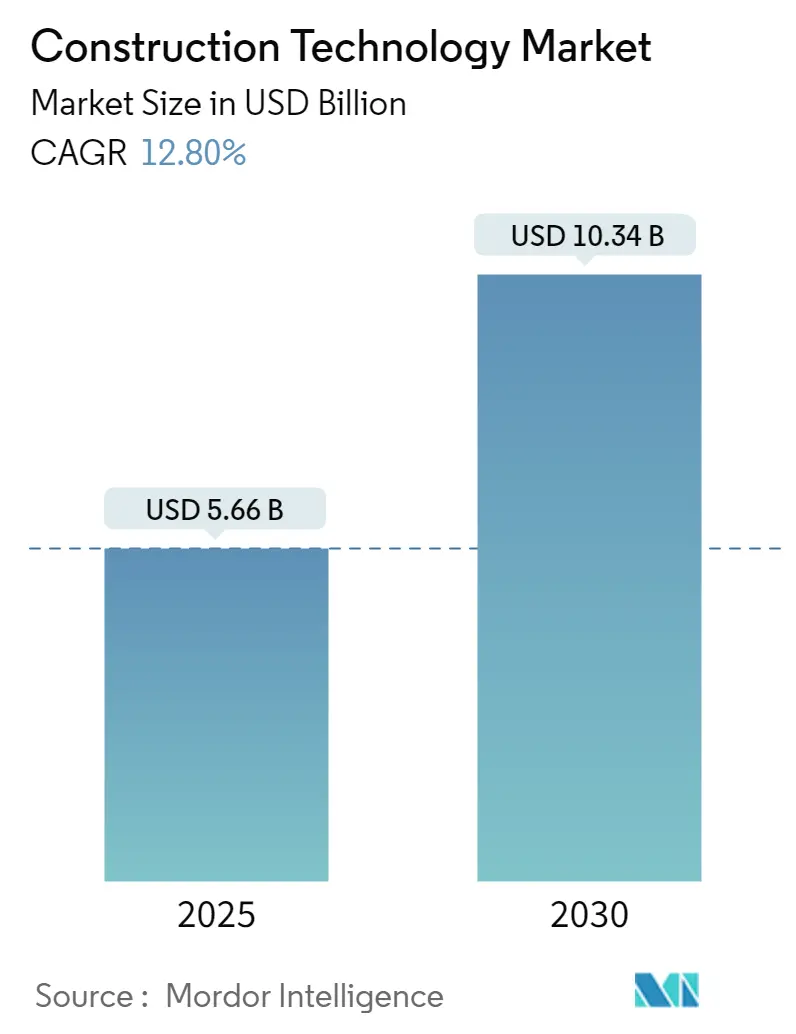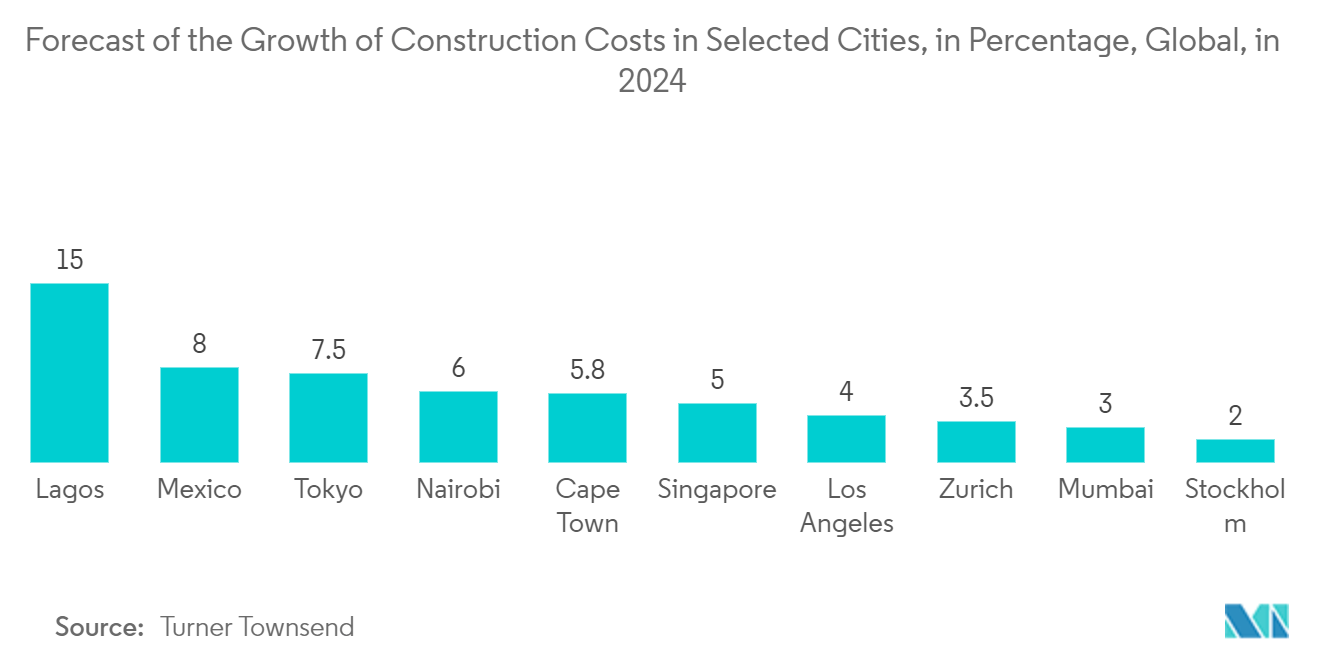| Study Period | 2019 - 2030 |
| Market Size (2025) | USD 5.66 Billion |
| Market Size (2030) | USD 10.34 Billion |
| CAGR (2025 - 2030) | 12.80 % |
| Fastest Growing Market | Asia Pacific |
| Largest Market | Europe |
| Market Concentration | Low |
Major Players*Disclaimer: Major Players sorted in no particular order |
Construction Technology Market Analysis
The Construction Technology Market size is estimated at USD 5.66 billion in 2025, and is expected to reach USD 10.34 billion by 2030, at a CAGR of 12.8% during the forecast period (2025-2030).
- Technological innovations, including AI, IoT, and Robotics, are pivotal in enhancing productivity and ensuring safety on construction sites. This rising demand for AI, IoT, and robotics solutions is fueling the construction technology market and spurring heightened investments in research and development. Furthermore, these advancements pave the way for novel business models, such as rental services for construction robotics and AI-driven construction management platforms. However, integrating these technologies underscores the necessity for a skilled workforce proficient in AI, IoT, and robotics. This demand opens up new job opportunities and amplifies the need for specialized training programs.
- Several construction projects are increasingly harnessing the power of AI. The Swedish construction firm employs AI-driven predictive analytics to anticipate potential delays and budget overruns. By scrutinizing historical data alongside external influences, they can preemptively modify schedules and allocate resources, thereby reducing risks and enhancing project results. Meanwhile, Autodesk's Generative Design software utilizes AI to sift through numerous design possibilities, all tailored to user-specified parameters. This empowers architects and engineers to refine designs, considering structural strength, material efficiency, and sustainability, resulting in efficient and cost-effective solutions.
- Further, rapid urbanization propels the construction technology market, compelling the industry to embrace innovative solutions for quicker and more efficient construction methods. This urgency for speed and efficiency fuels substantial investments in construction technology firms and R&D endeavors. A burgeoning market for these tech solutions emerges as construction firms pivot to new technologies in response to urbanization's demands.
- However, smaller companies or those operating on tight budgets often need help to bear the costs of expensive software licenses for BIM software, AI-driven platforms, and other construction technology solutions. Additionally, embracing technologies such as robotics, 3D printing, and sophisticated surveying tools demands hefty investments in specialized hardware, posing a considerable financial strain. Aligning to this, these technologies necessitate employee training, incurring expenses related to training programs, travel, and potential dips in productivity during the learning phase.
- According to the IMF, the global inflation rate is expected to decrease from 6.78% in 2023 to 5.94% in 2024. The construction technology market's response to a declining inflation rate hinges on various factors: the extent of the decline, the prevailing economic conditions, and the technologies. As businesses acclimate to the shifting economic landscape, adopting new technologies might experience a temporary lull. However, over the long haul, a consistent economic backdrop marked by reduced inflation could foster a more inviting atmosphere for investments in construction technology, subsequently fueling innovation and expansion.
Construction Technology Market Trends
Building Information Modeling (BIM) Software is Expected to Hold Significant Market Share
- Building Information Modeling (BIM) software plays a pivotal role in refining the planning and execution of construction projects. By enabling the creation of cohesive 3D models that centralize all project data, BIM software supersedes traditional 2D drawings. This holistic approach streamlines communication and enhances stakeholder collaboration, driving efficiency throughout the project's lifecycle.
- Globally, countries like the United Kingdom are accelerating BIM adoption through mandatory regulations. As of February 2023, public-funded projects in the UK must adhere to the UK BIM Framework. This requirement stems from the Information Management Mandate outlined in the TIP Roadmap to 2030 and aligns with the Government's expectations outlined in the Construction Playbook. These regulations apply universally, covering roads, rails, buildings, and more. Additionally, nations such as India, Hong Kong, France, South Korea, Germany, and Italy increasingly embrace BIM technology.
- Furthermore, BIM's utility extends beyond mere design, playing a crucial role in the field by ensuring data accuracy and minimizing rework. It boosts the visibility of project details among teams, leading to more accurate planning and execution. Experts forecast a growing emphasis on data-driven management in BIM, harnessing AI for enhanced decision-making and operational efficiency.
- Beyond project execution, BIM is invaluable in post-construction phases, assisting with maintenance schedules to ensure that structures remain up to code and upkeep costs are optimized. Additionally, BIM lays the groundwork for virtual reality applications in construction, facilitating virtual simulations that enhance planning and engage stakeholders.
- Turner & Townsend reported that in 2024, Lagos, Nigeria, was poised to rank among the global leaders in construction cost growth. In contrast, New York City, USA, was projected to see a 4 percent increase in construction costs. Rising construction expenses in major cities are pushing firms to adopt BIM software to cut costs, boost efficiency, and mitigate risks. Thus, the firms must be ready to allocate resources and navigate the hurdles of effective BIM implementation.
- BIM has evolved from a mere design tool to a comprehensive project management solution, revolutionizing the construction industry. As advancements continue and regulatory adoption widens, BIM's influence on enhancing project efficiency, safety, and cost management becomes increasingly pronounced, underscoring its pivotal role in contemporary construction practices.
Europe is Expected to Hold Significant Market Share
- As European cities witness swift population growth, the demand for housing, infrastructure, and urban renewal projects surges. The European Union's emphasis on infrastructure development—especially in transportation, energy, and digital connectivity fuels investments in construction technology, aiming to enhance project delivery and efficiency. As per Turner & Townsend, as of 2024, Geneva and Zurich, two prominent Swiss cities, boasted some of Europe's steepest construction costs, exceeding USD 5,000 per square meter. London ranked third at USD 4,473 per square meter.
- Europe leads the charge against climate change, implementing strict regulations on energy efficiency, resource use, and carbon emissions in the construction sector. According to the Institute of Building Technology, buildings register for one-third of the total waste generated in the EU. Several regulations and actions have been implemented to manage waste disposal and treatment effectively and sustainably in response to this issue. Adopting construction technology is pivotal in adhering to these regulations, offering sustainable materials, energy-efficient designs, and waste-minimization solutions.
- Technological advancements like Building Information Modeling (BIM) are becoming increasingly prominent in Europe, enhancing design, planning, and construction management. These advancements boost project efficiency, minimize waste, and foster better stakeholder collaboration. Furthermore, the emergence of digital twins—virtual replicas of physical assets—is transforming the construction landscape.
- They offer real-time insights into building performance, support predictive maintenance, and streamline operations. Additionally, integrating AI and ML into construction technology automates tasks, fine-tunes resource allocation, and elevates decision-making processes.
- Moreover, the parliament has approved a new Regulation to standardize the marketing conditions for construction products. This regulation will set unified rules for the market availability of construction products. It will also address public procurement measures, mandating the commission to specify minimum environmental sustainability standards for these products through delegated acts.
- In line with public procurement directives, if contracts stipulate minimum environmental sustainability criteria based on harmonized technical specifications, authorities must adhere to the standards outlined in the delegated acts. Numerous European nations are adopting public procurement policies promoting innovative construction technologies, propelling market growth.

Construction Technology Industry Overview
The construction technology market is highly competitive, with numerous players vying for market share. Companies are investing in research and development to create new and improved technologies, such as advanced construction materials. Additionally, these players are considering mergers, acquisitions, and partnerships to remain competitive in the market. A few key players in the market include Autodesk Inc., Trimble Inc., Procore Technologies, Inc., Bentley Systems, Incorporated, and Buildots.
- May 2024 - Buildots unveiled its latest innovation, the Delay Forecast feature. This AI-driven tool identifies potential delay risks and promptly notifies construction teams about pace discrepancies. Such proactive alerts empower teams to address and mitigate delays before they magnify. Additionally, the feature offers detailed insights at the activity level, pinpointing the root causes of delays. This capability allows project managers to continuously refine their strategies and enhance overall performance.
- April 2024 - The architecture, engineering, and construction (AEC) sectors are increasingly leveraging the interoperability of geographic information systems (GIS) and building information modeling (BIM) to cut costs and enhance efficiency in construction projects. Esri and Autodesk are bolstering their strategic alliance to support AEC organizations. By integrating ArcGIS Basemaps with Civil 3D and AutoCAD, AEC professionals can access enriched geospatial data and advanced mapping capabilities. These integrations strengthen the bond between GIS and BIM, offering tangible business benefits to architects, engineers, planners, and contractors.
Construction Technology Market Leaders
-
Autodesk Inc.
-
Trimble Inc.
-
Procore Technologies, Inc.
-
Bentley systems, incorporated
-
Buildots
- *Disclaimer: Major Players sorted in no particular order

Construction Technology Market News
- July 2024: Buildots introduced Integrated Tracking as its latest initiative to propel Performance-Driven Construction Management (PDCM). This move consolidates fragmented progress data into a unified, actionable dataset. By harnessing advanced analytics, users can better anticipate delays, pinpoint root causes, fine-tune task scheduling, and bolster project oversight. This innovative feature empowers project teams to utilize AI for automated progress tracking. Simultaneously, it allows professionals to log and verify tasks requiring human oversight. Examples include confirming the presence of electrical wiring in conduits and completing essential tasks like quality assurance checks and inspections.
- May 2024: Roofer.com secured USD 7.5 million in a seed round spearheaded by Mucker Capital. The drone conducts scans that generate detailed inspection reports for properties utilizing AI. All inspections are stored on the platform RoofFax, which the company likens to the vehicle condition-monitoring software CarFax. As stated in the release, while Roofer.com primarily targets re-roofing homes for consumers, it also boasts a burgeoning enterprise segment catering to multifamily apartments and commercial buildings. Owing to this funding, the company is set to expand into Austin, Texas - marking its second location and inaugural site outside its Dallas headquarters.
Construction Technology Industry Segmentation
Construction technology encompasses the cutting-edge tools, equipment, and methodologies employed in the construction sector to boost efficiency, safety, and sustainability. This domain spans diverse solutions, including 3D printing, drones, augmented reality, and automated machinery, all aimed at bolstering pre-construction activities and elevating the quality of building materials produced. The study tracks the revenue generated by selling several market vendors' solutions and services. The study also tracks the underlying growth trends and macroeconomic impacts on the market.
The construction technology market is segmented by type (solutions [virtual and augmented reality, artificial intelligence, 3D printing, building information modeling (BIM) software, automated data collection and predictive analytics, drones, robotics, project management software, wearables, other Types (digital twin, sustainable technology, blockchain technology, 4D simulation, etc.)] and services) and geography (North America, Europe, Asia, Australia and New Zealand, Latin America, and Middle East and Africa). The market sizes and forecasts are provided in terms of value (USD) for all the above segments.
| By Type | Solutions | Virtual and Augmented Reality |
| Artificial Intelligence | ||
| 3D Printing | ||
| Building Information Modeling (BIM) Software | ||
| Automated Data Collection and Predictive Analytics | ||
| Drones | ||
| Robotics | ||
| Project Management Software | ||
| Wearables | ||
| Other Types (Digital Twin, Sustainable Technology, Blockchain Technology, 4D Simulation, etc.) | ||
| Services | ||
| By Geography*** | North America | |
| Europe | ||
| Asia | ||
| Australia and New Zealand | ||
| Latin America | ||
| Middle East and Africa |
Construction Technology Market Research FAQs
How big is the Construction Technology Market?
The Construction Technology Market size is expected to reach USD 5.66 billion in 2025 and grow at a CAGR of 12.80% to reach USD 10.34 billion by 2030.
What is the current Construction Technology Market size?
In 2025, the Construction Technology Market size is expected to reach USD 5.66 billion.
Who are the key players in Construction Technology Market?
Autodesk Inc., Trimble Inc., Procore Technologies, Inc., Bentley systems, incorporated and Buildots are the major companies operating in the Construction Technology Market.
Which is the fastest growing region in Construction Technology Market?
Asia Pacific is estimated to grow at the highest CAGR over the forecast period (2025-2030).
Which region has the biggest share in Construction Technology Market?
In 2025, the Europe accounts for the largest market share in Construction Technology Market.
What years does this Construction Technology Market cover, and what was the market size in 2024?
In 2024, the Construction Technology Market size was estimated at USD 4.94 billion. The report covers the Construction Technology Market historical market size for years: 2019, 2020, 2021, 2022, 2023 and 2024. The report also forecasts the Construction Technology Market size for years: 2025, 2026, 2027, 2028, 2029 and 2030.
Construction Technology Industry Report
Statistics for the 2025 Construction Technology market share, size and revenue growth rate, created by Mordor Intelligence™ Industry Reports. Construction Technology analysis includes a market forecast outlook for 2025 to 2030 and historical overview. Get a sample of this industry analysis as a free report PDF download.







